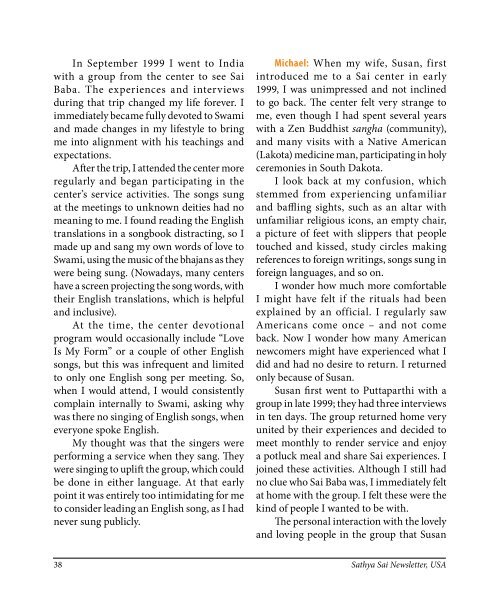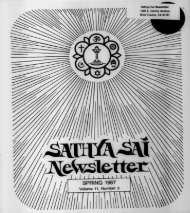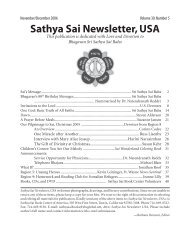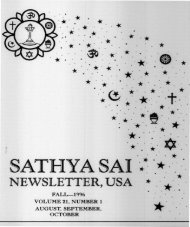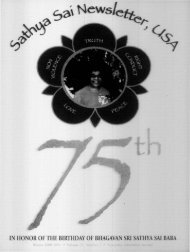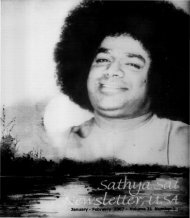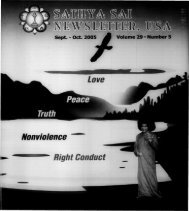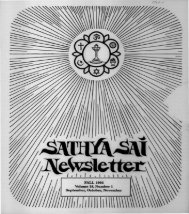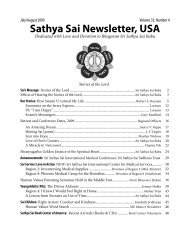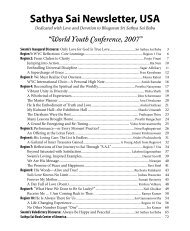Sathya Sai Newsletter
2013 - 3rd Quarter (2.4 mb) - USA Sai Organization
2013 - 3rd Quarter (2.4 mb) - USA Sai Organization
You also want an ePaper? Increase the reach of your titles
YUMPU automatically turns print PDFs into web optimized ePapers that Google loves.
In September 1999 I went to India<br />
with a group from the center to see <strong>Sai</strong><br />
Baba. The experiences and interviews<br />
during that trip changed my life forever. I<br />
immediately became fully devoted to Swami<br />
and made changes in my lifestyle to bring<br />
me into alignment with his teachings and<br />
expectations.<br />
After the trip, I attended the center more<br />
regularly and began participating in the<br />
center’s service activities. The songs sung<br />
at the meetings to unknown deities had no<br />
meaning to me. I found reading the English<br />
translations in a songbook distracting, so I<br />
made up and sang my own words of love to<br />
Swami, using the music of the bhajans as they<br />
were being sung. (Nowadays, many centers<br />
have a screen projecting the song words, with<br />
their English translations, which is helpful<br />
and inclusive).<br />
At the time, the center devotional<br />
program would occasionally include “Love<br />
Is My Form” or a couple of other English<br />
songs, but this was infrequent and limited<br />
to only one English song per meeting. So,<br />
when I would attend, I would consistently<br />
complain internally to Swami, asking why<br />
was there no singing of English songs, when<br />
everyone spoke English.<br />
My thought was that the singers were<br />
performing a service when they sang. They<br />
were singing to uplift the group, which could<br />
be done in either language. At that early<br />
point it was entirely too intimidating for me<br />
to consider leading an English song, as I had<br />
never sung publicly.<br />
Michael: When my wife, Susan, first<br />
introduced me to a <strong>Sai</strong> center in early<br />
1999, I was unimpressed and not inclined<br />
to go back. The center felt very strange to<br />
me, even though I had spent several years<br />
with a Zen Buddhist sangha (community),<br />
and many visits with a Native American<br />
(Lakota) medicine man, participating in holy<br />
ceremonies in South Dakota.<br />
I look back at my confusion, which<br />
stemmed from experiencing unfamiliar<br />
and baffling sights, such as an altar with<br />
unfamiliar religious icons, an empty chair,<br />
a picture of feet with slippers that people<br />
touched and kissed, study circles making<br />
references to foreign writings, songs sung in<br />
foreign languages, and so on.<br />
I wonder how much more comfortable<br />
I might have felt if the rituals had been<br />
explained by an official. I regularly saw<br />
Americans come once – and not come<br />
back. Now I wonder how many American<br />
newcomers might have experienced what I<br />
did and had no desire to return. I returned<br />
only because of Susan.<br />
Susan first went to Puttaparthi with a<br />
group in late 1999; they had three interviews<br />
in ten days. The group returned home very<br />
united by their experiences and decided to<br />
meet monthly to render service and enjoy<br />
a potluck meal and share <strong>Sai</strong> experiences. I<br />
joined these activities. Although I still had<br />
no clue who <strong>Sai</strong> Baba was, I immediately felt<br />
at home with the group. I felt these were the<br />
kind of people I wanted to be with.<br />
The personal interaction with the lovely<br />
and loving people in the group that Susan<br />
38 <strong>Sathya</strong> <strong>Sai</strong> <strong>Newsletter</strong>, USA


